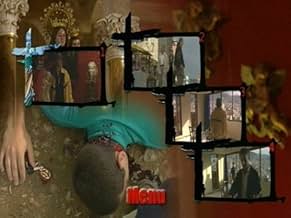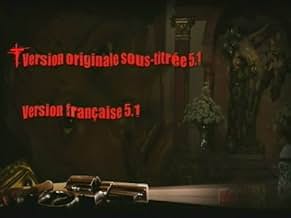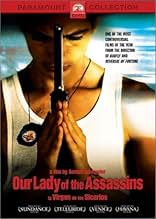CALIFICACIÓN DE IMDb
6.8/10
4.4 k
TU CALIFICACIÓN
El escritor F. Vallejo regresa a Medellín tras más de 30 años de ausencia. Conoce a Alexis, de 16 años. Alexis es el tipo de asesino que noquea a quien sea en cuanto se lo ordenan. Los dos s... Leer todoEl escritor F. Vallejo regresa a Medellín tras más de 30 años de ausencia. Conoce a Alexis, de 16 años. Alexis es el tipo de asesino que noquea a quien sea en cuanto se lo ordenan. Los dos se sienten mutualmente atraídos.El escritor F. Vallejo regresa a Medellín tras más de 30 años de ausencia. Conoce a Alexis, de 16 años. Alexis es el tipo de asesino que noquea a quien sea en cuanto se lo ordenan. Los dos se sienten mutualmente atraídos.
- Premios
- 3 premios ganados y 3 nominaciones en total
Opiniones destacadas
Occasionally venturing into dreamlike surrealism, the movie mostly hits you with a heavy dose of cinema verite. The movie is about the city of Medellin in the same way that Midnight Cowboy is about New York. The characters aren't dealing with the problem of staying human in a huge metropolis, but staying human in the midst of instability that verges on anarchy.
The effects of fifty years of civil war aggravated by narcotrafficking and the associated crime are shown in two ways, which are the central themes of the film: the shift from the old and traditional to the modern, and the loss of value that human life has suffered. The banality of the several killings in the movie drives home the second, and the explorations that Fernando and his two boyfriends (sequential, not simultaneous) take through the city show the first.
The movie is violent like the Godfather is violent: the killings are not gratuitous, they are there to make a point. As a document of life in an industrial Andean city which just happens to be the second city of the country poised to become the next Vietnam, or better said, the next El Salvador, La virgen de los sicarios is excellent. It is sophisticated in its writing and its photography. The characters are human and complex. It ought to be in far wider release than just one screen in the whole L.A. area - which happens to be on the West Side, where Spanish-speaking people typically don't live.
The effects of fifty years of civil war aggravated by narcotrafficking and the associated crime are shown in two ways, which are the central themes of the film: the shift from the old and traditional to the modern, and the loss of value that human life has suffered. The banality of the several killings in the movie drives home the second, and the explorations that Fernando and his two boyfriends (sequential, not simultaneous) take through the city show the first.
The movie is violent like the Godfather is violent: the killings are not gratuitous, they are there to make a point. As a document of life in an industrial Andean city which just happens to be the second city of the country poised to become the next Vietnam, or better said, the next El Salvador, La virgen de los sicarios is excellent. It is sophisticated in its writing and its photography. The characters are human and complex. It ought to be in far wider release than just one screen in the whole L.A. area - which happens to be on the West Side, where Spanish-speaking people typically don't live.
10jvframe
Our Lady Of Assassins showed at the Brisbane International Film Festival. It left me initially distraught and other members of the audience obviously felt the same. After a bit of thought, I realised that it was indeed a powerful and beautifully created way of presenting the desperate nature of life in Medellin. The main character, who was born and raised in the town, remembers how potentially violent it was even 40 years earlier, yet seems to be shocked by how much it has decayed. It is strange that he is also quite complicit in inciting violence, while seeming to be just looking for love.
The film forces the audience to question the day to day value of life and just how much violence we can allow ourselves to tolerate. But in Medellin the solution is certainly not in the hands of just one person.
A great trio of films showing the broad story of the cocaine phenomena would be "Our Lady Of Assassins", Ted Demme's "Blow" and "Traffic".
The film forces the audience to question the day to day value of life and just how much violence we can allow ourselves to tolerate. But in Medellin the solution is certainly not in the hands of just one person.
A great trio of films showing the broad story of the cocaine phenomena would be "Our Lady Of Assassins", Ted Demme's "Blow" and "Traffic".
Our Lady of The Assassins will have you either loving it or hating it. It polarizes because it never compels as a movie itself, but is laid out before each person, needing him or her to internalize the film. The movie speaks of living in a Columbian drug town and the irony as people get shot everyday by moral-less teens set against the beautiful city and sky. But the main character, an old gay writer, is never engaging or as articulate and thoughtful as one would expect from the "best known grammarian" from Columbia. In fact, as grammar is rigidly structured, so are the writer's banal comments about 'time being what you want it to be' and 'life only being lived to die.' The musings have been heard before, but with greater clarity and depth. There is no epiphany to be associated with any of his sayings. However, he meets a young former gang member, marked for death, named Alexis and they fall in love. The film is so detached that their love is the closest element to emotion, and still one cannot understand why this boy would sleep with a man who incessantly whines constantly. The shocking life in Medellin is the most compelling aspect of the movie and the movie still has points, it's just that they are not nearly poignant enough. They are shown by the director, but never cohesively placed into an argument. I really wished I could have liked this movie.
I saw the film at the Jerusalem Film Festival. It was a rather late screening, but the viewers were glued to their seats. It's a very gripping movie and extremely subversive in themes, language and visuals. It's very anti current-day Colombia, and no wonder the production didn't go very smoothly. Still I admire the support the film got from `official' institutions in Medellion. It's subversive in themes, because we basically have a gay couple, an older man (about 40-50) who indulges in having sex with minor boys (who do this willingly, and yet, it's rather shocking to the average viewer) in return for financial support, or rather indulging the boys in whatever they want to do. The couple goes around the city and is critical of every facet of the city and rightly so yet the tone is overtly cynical and `evil'. The lead boy, Alexis, goes around and kills whomever is threatening him and his sugar-daddy I think he executed 4 people once a confrontation was about to happen, and 4 more were other kids who were after him. S this shooting spree is depicted in a somewhat accepting manner, as if this is the way to do these things in Colombia. They ridicule almost every aspect of life church, police, government, the drug lords, poor and beggars, the bourgeoisie, other gays, and even themselves. In that respect, it's a very Pasolini movie, although the realism here is a real one and not made for the sake of a socialist agenda. The writer and his two boy-lovers are very lost, although they always know where they are, and the ending is pretty bad, as expected. The film shows no hope for the Colombian people, as they are stuck in a country ran by corrupt officials, gangs and drug lords. The writer has great lines, one of my favorite was about him hating people who whistle, because they shouldn't try and imitate the art that was given to the birds
A good movie, with a 7/10 as far as I can say. Acting-wise since I don't speak Spanish, it was credible to my ears, though the boys did seem to quote their lines mechanically at times.
Barbet Schroeder's Our Lady of the Assassins is a perplexing film. Yet, it is ultimately rewarding in ways that most films aren't.
Shot in high definition digital video, the film has an immediacy to it that cannot be simulated by film. At first, the immediacy seems to cheapen the look and one wonders what Schroeder was thinking when he decided to undertake this format. Yet as the complexity of the story progresses, we seem to be "taken in" by the video's hypnotic effect and we realize that we are viewing a medium with its own look, feel and characteristics and we accept it.
About an older man who befriends and enters into a relationship with a young ex-gang member, the story takes a while to unfold. In the beginning it seems all but pointless, yet within the hour, we are caught up in a film of overwhelming depth and emotional power. Schroeder deserves tremendous credit for having the courage to make a movie in which the main character openly denounces the church and where themes of political corruption and anarchy in a real world setting actually exist.
Most disturbing is that the themes in this movie ring true with an authenticity that cannot be challenged. We are simultaneously horrified yet held captive by a reality which we don't want to believe exists but that we know already does, not only in Colombia, where the film is set, but elsewhere as well. Schroeder is a master here of making the "city" of Medellin just as much a character as the protagonists. He charges the environment with an electricity that seems to pervade the screen and crawl into our psyches.
Unfortunately it is the medium itself which may prevent Our Lady of the Assassins from becoming a commercial success or as being taken seriously by a lot of people. But film purists and those who enjoyed the gritty realism of similar films like Pixote and Santa Sangre, should love this one.
Shot in high definition digital video, the film has an immediacy to it that cannot be simulated by film. At first, the immediacy seems to cheapen the look and one wonders what Schroeder was thinking when he decided to undertake this format. Yet as the complexity of the story progresses, we seem to be "taken in" by the video's hypnotic effect and we realize that we are viewing a medium with its own look, feel and characteristics and we accept it.
About an older man who befriends and enters into a relationship with a young ex-gang member, the story takes a while to unfold. In the beginning it seems all but pointless, yet within the hour, we are caught up in a film of overwhelming depth and emotional power. Schroeder deserves tremendous credit for having the courage to make a movie in which the main character openly denounces the church and where themes of political corruption and anarchy in a real world setting actually exist.
Most disturbing is that the themes in this movie ring true with an authenticity that cannot be challenged. We are simultaneously horrified yet held captive by a reality which we don't want to believe exists but that we know already does, not only in Colombia, where the film is set, but elsewhere as well. Schroeder is a master here of making the "city" of Medellin just as much a character as the protagonists. He charges the environment with an electricity that seems to pervade the screen and crawl into our psyches.
Unfortunately it is the medium itself which may prevent Our Lady of the Assassins from becoming a commercial success or as being taken seriously by a lot of people. But film purists and those who enjoyed the gritty realism of similar films like Pixote and Santa Sangre, should love this one.
¿Sabías que…?
- TriviaGiven the fact that Anderson Ballesteros did a great job portraying a tough hitman with street knowledge, all the roles he got later were pretty much the same, for example, playing as Pablo Escobar's main hitman on "El Patrón del Mal"
Selecciones populares
Inicia sesión para calificar y agrega a la lista de videos para obtener recomendaciones personalizadas
- How long is Our Lady of the Assassins?Con tecnología de Alexa
Detalles
- Fecha de lanzamiento
- Países de origen
- Sitio oficial
- Idiomas
- También se conoce como
- Our Lady of the Assassins
- Locaciones de filmación
- Productoras
- Ver más créditos de la compañía en IMDbPro
Taquilla
- Total en EE. UU. y Canadá
- USD 525,330
- Fin de semana de estreno en EE. UU. y Canadá
- USD 56,069
- 9 sep 2001
- Total a nivel mundial
- USD 624,525
- Tiempo de ejecución
- 1h 41min(101 min)
- Color
- Mezcla de sonido
- Relación de aspecto
- 1.78 : 1
Contribuir a esta página
Sugiere una edición o agrega el contenido que falta
























